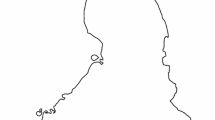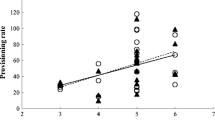Abstract
The influences of the temporal change in food supply on the parental feeding effort and breeding success of silvereyes,Zosterops lateralis chlorocephala, was investigated on Heron Island, Australia. Food supply (arthropods and figs) declined as the breeding season progressed. The parental feeding rate and growth of nestlings were lower when food supply was poor. When available, dominant pairs fed their young more figs and fewer arthropods than lower ranking pairs. Dominant pairs raised heavier young than lower ranking pairs when food supply was poor, while there were no significant differences between them when food supply was rich. When food supply was rich, pairs delivering greater amounts of arthropods reared nestlings better, whereas feeding more figs did not improve growth of nestlings. When food supply was poor, pairs spending a longer time at the nest reared nestlings better.
Similar content being viewed by others
References
Biermann G. C. &Sealy S. G. (1982) Parental feeding of nestling Yellow Warblers in relation to brood size and prey availability.Auk 99: 332–341.
Boag P. T. (1987) Effects of nestling diet on growth and adult size of Zebra finches (Poephila guttata).Auk 104: 155–166.
Catterall C. P. (1985) Winter energy deficits and the importance of fruit versus insects in a tropical island bird population.Aust. J. Ecol. 10: 265–279.
Catterall C. P., Wyatt W. S. &Henderson L. J. (1982) Food resources, territory density and reproductive success of an island Silvereye populationZosterops lateralis.Ibis 124: 405–421.
Grundel R. (1990) The role of dietary diversity, prey capture sequence and individuality in prey selection by parent Mountain chickadees (Parus gambeli).J. Anim. Ecol. 59: 959–976.
Henderson L. J. (1977) Relations among figs, fig wasps, and silvereyes on Heron Island. MSc thesis, University of Queensland.
Immelmann K. (1971) Ecological aspects of periodic reproduction. In:Avian Biology, Vol. 1. (eds D. S. Farner & J. R. King) pp. 341–389. Academic Press, New York.
Kikkawa J. (1980) Winter survival in relation to dominance classes among SilvereyesZosterops lateralis chlorocephala of Heron Island, Great Barrier Reef.Ibis 122: 437–446.
Kikkawa J. &Wilson J. M. (1983) Breeding and dominance among the Heron Island SilvereyesZosterops lateralis chlorocephala.Emu 83: 181–198.
Lack D. (1966)Population Studies of Birds. Clarendon Press, Oxford.
MacArthur R. H. (1972)Geographical Ecology. Harper & Row, New York.
Mertens J. A. L. (1977) Thermal conditions for successful breeding in Great Tits (Parus major L.). I. Relation of growth and development of temperature regulation in nestling great tits,Oecologia 28: 1–29.
Moeed A. (1979) Foods of the silvereye (Zosterops lateralis; Aves) near Nelson, New Zealand.NZ J. Zool. 6: 475–479.
Moreno J. (1987) Parental care in the WheatearOenanthe oenanthe: Effects of nestling age and brood size.Ornis Scand. 18: 291–301.
Murphy M. T. (1986) Temporal components of reproductive variability in Eastern kingbirds (Tyrannus tyrannus).Ecology 67: 1483–1492.
Newton I. (1979)Population Ecology of Raptors. Poyser, Berkhamsted.
Newton I. &Marquiss M. (1984) Seasonal trend in the breeding performance of Sparrowhawks.J. Anim. Ecol. 53: 809–829.
Piersma T. &Davidson N. C. (1991) Confusions of mass and size.Auk 108: 441–444.
Tinbergen J. M. (1981) Foraging decisions in starlingsSturnus vulgaris L.Ardea 69: 1–67.
Wiebe K. L. &Bortolotti G. R. (1992) Facultative sex ratio manipulation in American kestrels.Behav. Ecol. Sociobiol. 30: 379–386.
Wilson S. M. &Kikkawa J. (1988) Post-fledging parental investment in the Capricorn Silvereye.Emu 88: 81–87.
Zack S. (1986) Behaviour and breeding biology of the cooperatively breeding grey-backed fiscal shrikeLanius excubitorius in Kenya.Ibis 128: 214–233.
Zack S. &Ligon J. D. (1985) Cooperative breeding inLanius shrikes. I. Habitat and demography of two sympatric species.Auk 102: 754–765.
Author information
Authors and Affiliations
About this article
Cite this article
Eguchi, K. Temporal changes in food resources, parental feeding and breeding success of Heron Island silvereyes,Zosterops lateralis chlorocephala . Ecol. Res. 8, 319–327 (1993). https://doi.org/10.1007/BF02347191
Accepted:
Issue Date:
DOI: https://doi.org/10.1007/BF02347191




